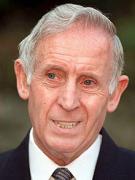William James Hamilton was one of the leading anatomists in the United Kingdom, not least as a prolific researcher and writer in the field, but also as an administrator, manager and teacher.
Hamilton was born at Ballytober, near Whitehead, County Antrim, son of a master mariner and ship’s captain, Andrew Hamilton, and Emeline Gertrude Hunter. He was a graduate of the medical school of Queen’s University, Belfast where his academic record was outstanding: along with several prizes, most importantly he obtained a BSc in physiology with first class honours in 1926, then an MB in 1929, not only with first class honours but also being placed first in his year. He took up a post as house officer at the Royal Victoria Hospital, Belfast, and while there read for his MSc which he was awarded in 1931 (with a thesis entitled “Regeneration and restoration of epithelium and endothelium of the uterus of the guinea pig after parturition”).
He then moved to Scotland, where spent four years (1931-1935). He was lecturer in anatomy at the University of Glasgow under the celebrated Thomas Hastie Bryce, Regius Professor of Anatomy at the University of Glasgow from 1909 to 1935 (one of whose notable contributions to knowledge was showing that the Neolithic people of Arran were of short stature and dolichocephalic as distinct from those of the Bronze Age). Nevertheless, his influence on Hamilton was to infuse him with an interest in his principal field of expertise, embryology, and Hamilton studied for a DSc, which was conferred on him in 1934. The University awarded him the Struthers Medal and Prize (“awarded biannually by the Senate on the nomination of the Regius Professor of Anatomy for the best original research or the best dissection or preparation or series of dissections or preparations relating to any part of Anatomy, human or comparative”) and in 1934 he was elected Fellow of the Royal Society of Edinburgh.
In 1935 he moved to London, to become Deputy Director of Anatomy at St Thomas’s Hospital, and in 1936 he was appointed Professor of Anatomy at the University of London, holding this Chair at St Bartholomew’s Hospital, London. That year he was also awarded the degree of MD from Queen’s University, Belfast for his thesis “The early development of the mesoblast and notochord with special reference to the ferret”. The award was made with high commendation. 1938 brought him a further distinction, the Neill Prize of the Royal Society of Edinburgh, awarded for work in Natural History. From 1945-1947 he was Regius Professor of Anatomy at Glasgow, then returned to London as Foundation Professor at Charing Cross Hospital School, were he remained until retirement in 1970; he was Dean from 1956-1962. In this latter capacity especially his direction was energetic, forceful (to a fault, some said), and certainly successful. He expanded the School both academically, establishing Chairs in Medicine, Surgery, and Obstetrics and Gynaecology; and he expanded it physically, with new premises on Fulham Road. He was appointed Professor Emeritus in 1971. Always energetic and curious, he continued to research, basing himself at the Institute of Basic Medical Sciences in Lincoln’s Inn Fields, and always showed an interest in new teaching methods, such as instructional films.
Hamilton was a prodigious writer. Besides numerous articles and book chapters, and co-authorships, often with James Dixon Boyd, another distinguished anatomist and graduate of Queen’s University. Probably the most important of these publications was Human embryology: prenatal development of form and function, which first appeared in 1938 (co-authored with Boyd and HW Mossman), which would go through several editions and numerous reprints. A second joint publication between Hamilton and Dixon Boyd, The Human Placenta, appeared only after the latter’s death, in 1970. Many esteemed the co-operation between Dixon Boyd and Hamilton to be that of two outstanding anatomists, Hamilton slightly less intellectually critical, though energetic and well-organised, Dixon Boyd intellectually more incisive, a little less rigorous in practical ways – they complemented each other.
He had other distinctions than those already noted. He was President of the Anatomical Society of Great Britain and Ireland (now The Anatomical Society), 1954-1955 and was elected Fellow of the Royal College of Obstetricians and Gynaecologists in 1959. In 1963 he was elected Fellow of the Royal College of Surgeons awarded him their John Hunter Medal and Triennial Prize in 1973. He was also sometime Professor of Anatomy at the Royal Academy of Arts. Queen’s University, Belfast conferred on him the degree of Doctor of Science, honoris causa, in 1963.
Hamilton was undoubtedly a man of considerable force of character, determination, and clearsightedness. His philosophy and methodology of teaching were innovative: for example, he presented the body as a living entity in which structure and function were closely connected. Some saw his apparently unvarnished manner in a relatively negative light, but whether he would have been seen this way in his native, more plainly-spoken Ulster is doubtful. What was not doubtful was the respect and admiration in which he was deservedly held.
Hamilton married in 1933 Maime Young, from Belfast, with whom he had five children, all of whom followed medical careers.
| Born: |
21 July 1903 |
| Died: |
3 May 1975 |












